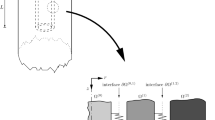Abstract
An analysis of microbuckling in a composite with anisotropic fibers under compression is presented. The modelling accounts for the fiber interaction, the distinct difference in the properties of the fibers and the matrix, and also for the presence of the external boundary. Results are calculated for cases of perfect fiber-matrix bonding. It is demonstrated that the critical loading parameters can depend essentially both on the fiber anisotropy and the fiber interaction. These factors must be properly accounted for in order to get acceptable estimations of the critical loads.
Similar content being viewed by others
References
DeFerran EM, Harris B. (1970) Compression strength of polyester resin reinforced with steel wires. Journal of Composite Materials 4: 62–72
Guynn E.G., Bradley W.L., Ochoa O.O. (1992) A parametric study of variables that affect fiber microbuckling initiation in composite laminates: Part 1 - Analyses. Journal of Composite Materials 26(11): 1594–1616
Schultheisz C.R., Waas A.M. (1996) Compressive failure of composites. Prog. Aerospace Sci. 32: 1–78
Guz A.N. (Edit.) (1992). Micromechanics of composite materials: Focus on Ukrainian research. Applied Mechanics Reviews, Special Issue, 45(2), 13-101.
Guz A.N., Lapusta Y. (1999) Three-dimensional problems of the near-surface instability of fiber composites in compression (model of a piecewise-uniform medium) (Survey). International Applied Mechanics 35(7): 641–670
Timoshenko S.P., Gere J.M. (1961) Theory of Elastic Stability, Second Edition. New York, NY, McGraw-Hill Book Company
Dow N.F., Grunfest I.J. (1960). Determination of most needed potentially possible improvements in materials for ballistic and space vehicles. General Electric Co, Space Sci Lab, TISR 60 SD 389.
Rosen B.W. (1965). Mechanics of composite strengthening. Fiber Composite Materials, American Society of Metals, 37-75.
Schuerch H. (1966) Prediction of compressive strength in uniaxial boron fiber-metal matrix composite materials. AIAA Journal 4(1): 102–106
Sadovsky M.A., Pu S.L., Hussain M.A. (1967). Buckling of microfibers. Journal of Applied Mechanics, December 1967, 1011-1016.
Guz A.N. (1969) Construction of a theory of stability of unidirectional fiber composites. Prikladnaya Mekhanika 5(2): 62–70 (in Russian)
Guz A.N. (1990). Fracture Mechanics of Composite Materials in Compression. Naukova Dumka, Kiev (in Russian).
Piggott MR, Harris B. (1980) Compression strength of carbon, glass and Kevlar-49 fiber reinforced polyester resins. Journal of Materials Science 15: 2523–2538
Lu G-Y, Mai Y-W. (1994) A theoretical model for the evaluation of interfacial properties of fiber-reinforced ceramics with the slice compression test. Composites science and technology 51(4): 565–574
Fleck N.A. (1997) Compressive failure of fiber composites. Advances in Applied Mechanics 33: 43–117
Guz A.N. (2009) Setting up a theory of stability of fibrous and laminated composites. International Applied Mechanics 45(6): 587–612
Lapusta Y., Wagner W. (2001a) On various material and fiber-matrix interface models in the near-surface instability problems for fibrous composites. Composites Part A 32: 413–423
Sun CT, Jun AW. (1994) Compressive strength of unidirectional fiber composites with matrix non-linearity. Composites science and technology 52(4): 577–588
Lapusta Y., Wagner W. (2001b) A numerical estimation of the effects of a cylindrical hole and imperfect bonding on stability of a fiber in an elastic matrix. International Journal for Numerical Methods in Engineering 51: 631–646
Potter DS, Gupta V, Hauert S. (2000) Effects of specimen size and sample aspect ratio on the compressive strength of graphite/epoxy laminates. Composites Science and Technology 60(12-13): 2525–2538
Evans AG, Adler WF. (1978) Kinking as a mode of structural degradation in carbon fiber composites. Acta Metallurgica 26: 725–738
Budiansky B, Fleck NA. (1994) Compressive kinking of fiber composites: a topical review. Applied Mechanics Reviews, Part 2 47(6): S246–S250
Kyriakides S, Ruff AE. (1997) Aspects of the failure and postfailure of fiber composites in compression. Journal of Composite Materials 31(20): 2000–2037
Lapusta Y., Wagner W. (2005) Effects of fiber anisotropy on the microbuckling loads for a fiber composite. International Journal of Fracture 131(4), L53–59 (2005)
Author information
Authors and Affiliations
Corresponding author
Rights and permissions
About this article
Cite this article
Lapusta, Y., Labesse-Jied, F., Samborskaya, A. et al. On the Effects of Interacting Anisotropic Fibers on the Microbuckling in a Composite. Int J Fract 167, 103–110 (2011). https://doi.org/10.1007/s10704-010-9524-3
Published:
Issue Date:
DOI: https://doi.org/10.1007/s10704-010-9524-3




